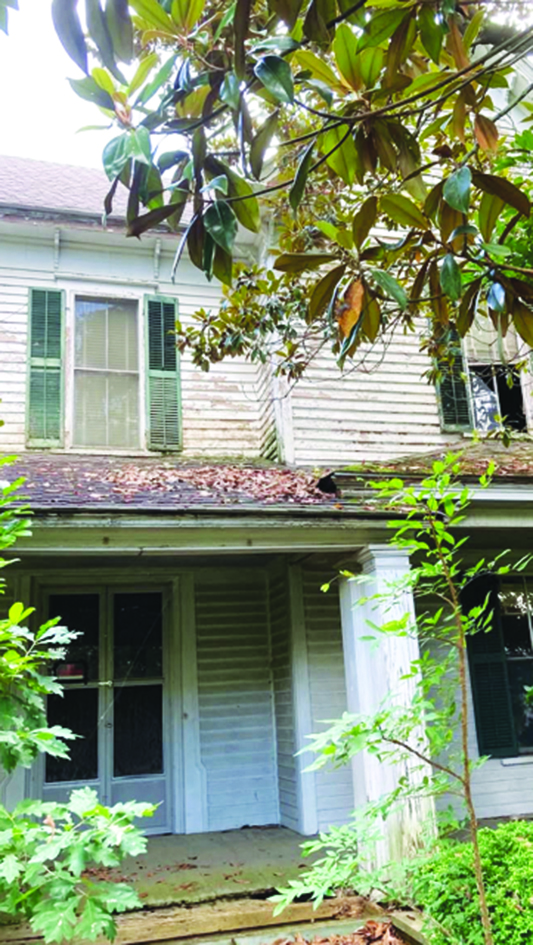The Literary Corner: Renegade Writer’s Guild
Published 10:41 am Tuesday, July 29, 2025
|
Getting your Trinity Audio player ready...
|
Radio
By Marie Craig
My recent article about the Bicentennial newspaper contained an error. I listed some businesses which are no longer functioning and included the radio station. That was a dumb dumb mistake because I have it on speed dial in my car. I’m not sure why I did that. But anyway, it gives me an excuse to write about our station in specific and radio itself in general.
I read the following information from the station’s website. It began in 1962, a 250-watt radio station with 10 investors. The first call letters were WSDC. This stood for “Winston-Salem, Salisbury and Davie County.” The current call letters are WDSL, “We Daily Serve the Lord.” The FM location on the dial is 96.5, and the AM station’s frequency is 1520. Their Website is https://wdsl965.com/ and they are on Facebook. You can listen online to music, interviews, and talk shows. My friend, Lisa Smith and Junior Dunn, have a weekly bluegrass program Saturdays from noon-2 p.m. There have been seven sets of owners with Farren K. Shoaf the current owner. The station and tower are located at 431 Eaton Road, Mocksville.
Back before television and the internet, that’s how folks got their news, weather info, and entertainment. I remember when I was a little girl that I couldn’t understand how music and talk could come out of a radio. Actually, I still don’t understand it, plus how a TV works, or how I can sit in one room with my phone, computer, or tablet and send a message through the air to my printer in another room.
My internet research discusses radio reception. A radio works by sending and receiving electromagnetic waves. A radio station encodes information (like music or speech) onto a radio wave and broadcasts it. Radio waves are electromagnetic waves of frequency between 3 Hertz (Hz) and 300 gigahertz (GHz). Your radio’s antenna intercepts this wave, and the radio then decodes the information and converts it into sound that you can hear through the speaker.
A quick search on the internet gave me at least 25 songs that have the word radio in the title. One song describes an old pickup truck and ends each verse with “but there ain’t nothing wrong with the radio.” An old gospel song includes “Turn your radio on and listen to the music in the air.” One of the longest-lived radio programs with a recent 5,000th session is the Tabernacle Choir from Salt Lake City.
While pondering the word “radio” I remembered “Radio Flyer.” This is what I discovered about these red wagons for children. Antonio Pasin started a factory to make wagons in Chicago in 1917. During a transition of name changes, he chose the name Radio Flyer for his wagons. The word Radio honored Marconi who had broadcast the first transatlantic radio signal in 1901, and the word Flyer honored Charles Lindbergh who completed the first solo, non-stop flight across the Atlantic in 1927.
Technology keeps giving us new equipment and entertainment, but the radio is here to stay.
New Bern
By Gaye Hoots
We celebrated my 80th birthday in New Bern, about 25 miles from Oriental, where I live. I have visited and toured the city many times, and it has an interesting history. The Tuscarora Indians inhabited it when Europeans first arrived. The Coree and Pamlico tribes lived in the region, and their traditions and beliefs continue to influence the present culture.
Europeans arrived in the 1700s and, within a few years, had driven the Indians out and established themselves. The town was settled in 1710 by German Palatines and the Swiss, which resonates with me because my Grandfather Fulk’s ancestors were German Palatine, while my grandmother’s ancestors were Swiss. The British governor’s palace, Tyron Palace, served as the capital of North Carolina from 1770-1792, when it relocated to Raleigh after a fire destroyed much of it. The only colonial town in North Carolina that is older is Bath, less than an hour’s drive away.
The Swiss named the city after the Canton of Bern, bern meaning bear, and as you approach the city on Highway 70, there is a large black bear pictured as part of the landscape. The downtown and waterfront feature numerous large and colorful bears. Many historic sites are within walking distance, and trolley tours are offered.
New Bern was captured and occupied by the Union during the Civil War and therefore was not destroyed as were many other southern cities. It became an encampment for freedmen, which comprised roughly half of the population during the war. After the war, some blacks were elected to political positions and served. This was later changed by the existing political party, and laws were made to exclude them.
After the war, the lumber industry developed, and the city thrived again. There are more than 150 historical buildings, including Tyron Palace. Downtown features gardens, and the waterfront is large. We ate at Baker’s Kitchen, one of the many excellent restaurants, and got desserts at a bakery that is an event center and beautifully decorated.
New Bern had many notable firsts, including that Pepsi Cola was developed here. The list includes the first fire department, printing press, and public banking institution in NC, the state’s first bookstore. NC’s first postal service, First Presbyterian Church, and Roman Catholic Church. It housed North Carolina’s first picture theater, and, notably, Josephine Burton of Craven County became the first Registered Nurse in the US on June 4, 1903.
There is a four-faced turn-of-the-century Baxter clock, one of three Seth Thomas post clocks still in use and listed on the national register. Nearby Havelock is home to Cherry Point Marine Air Station, which covers 16,000 acres.
Other historical towns with rich history and architecture include Bath, Edenton, Washington, and Kinston. Oriental, where I live, is also a quaint and beautiful waterfront area. It is a small town with no stoplights and no fast food, but with a beautiful harbor and good restaurants, mostly down-home cooking. It is known as the sailboat capital of NC, and there are three times as many sailboats as residents. Pamlico is not a wealthy county, but there are several beautiful and expensive developments, including River Dunes, an exclusive development with expansive harbor views and a public deli.
It is very hot here now, but we get constant breezes, which is why it is a desirable town for sailboats. If you decide to visit this area, I advise you to come by Hwy. 64 to 70 as opposed to I-40 to avoid Raleigh for the scenic drive. My GPS says it takes 15 minutes longer, but I make about the same time and arrive in a much better frame of mind and avoid major risks.
Passion, Another Irish Tale
By Julie Terry Cartner
People who have passion for what they do are blessed, but, equally, people who are able to learn from these are similarly fortunate. Those who truly have a passion for something are the greatest of ambassadors, and those of us who thirst for knowledge are lucky to learn from them. Such was the case with an amazing woman in Gaillimh, Galway, Ireland, our new friend, Stephanie.
My husband, a talented and avid knitter, had heard that traditional Aran cable patterns were as specific to Irish families as tartans are to the Scottish, and, knowing how much I love my Irish heritage, he thought to make me something in one of my family’s patterns. Unfortunately, we learned from Stephanie that this was not exactly accurate, which was disappointing, but she could still teach Danny the various patterns, along with so many other things. Our trip to Ireland was greatly enhanced by Stephanie, a woman just brimming with knowledge, enthusiasm, and passion for all she does.
We learned there are nine core stitches but an innumerable number of variations. What often happened is the knitter, traditionally the wife, chose a pattern or a series of patterns that she would put into everything she knit. Then, as her daughters married, they would take their mother’s pattern and add or change something to create her own design. In that way, the patterns were specific to a family. The reason, not so pleasant, was to help identify a fisherman’s body if he were lost at sea. If they couldn’t distinguish the face, they could often distinguish the knitting pattern on his sweater.
With the first lesson behind us, Stephanie, a geneticist by education, a milliner and horse breeder by trade, and a woman of Ireland by passion, continued to share her love of her country with us. It seemed that anything Stephanie didn’t know probably wasn’t worth knowing.
Her hats are fantastic, brilliant creations of fabric, beads, flowers, lace, and imagination, created for ladies to wear on occasions like church, horse races, and parties. Each unique to itself and creative beyond belief; I could have asked a million questions about each one, but Stephanie had so much more to share.
Her home, the family farm complete with a 200-year-old cottage of whitewashed stone walls and a thatched roof, and acres of farmland, is filled with history. She told us that there’s a fairy fort, or ring fort, on the land, along with an entire village from the Bronze Age, recently discovered, soon to be the site of an archaeological dig.
She also breeds and raises traditional Irish Cobs and shared much history of the breed.
Her farm has a turlough, which is a vanishing lake. It fills in the fall and empties in the spring, a phenomenon that is almost exclusively found in Ireland and Scotland due to the limestone base of these countries and the quantity of rainfall. Rain fills depressions in the land, creating lakes that become temporary homes for migrating birds, especially swans, a place to rest and feed before continuing on their journeys. As spring turns towards summer, the water slowly seeps through the limestone until the water all but disappears, leaving only small pools behind.
Stephanie told us that W.B. Yeats, the famous Irish poet, whose home was nearby, often visited Coole Park which borders her property. The park is on the other side of the turlough, and from Yeats’ visits there watching the swans, he wrote one of his famous poems, “The Wild Swans at Coole.” She encouraged us to visit his home, Thoor Ballylee, a 15th Century stone tower house, which we did the next day. She also suggested other places to see and the best places to eat. Stephanie was truly an ambassador for all things Irish, and her joy in sharing this love with us was evident.
I am so grateful to Stephanie and so many others from Ireland who exemplified true hospitality. The message we received repeatedly was … we are so fortunate to have you as our guests in our beloved country, and we are thrilled to share our passion with you. We could all learn much from the Stephanies of this world.





